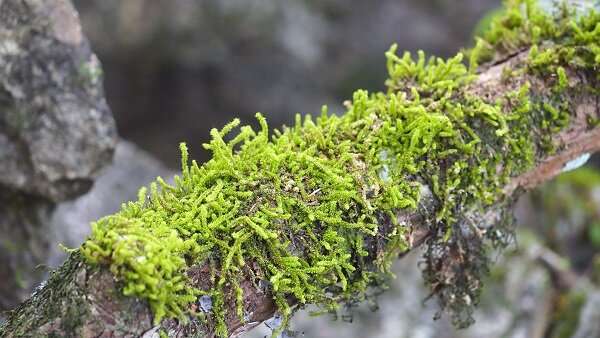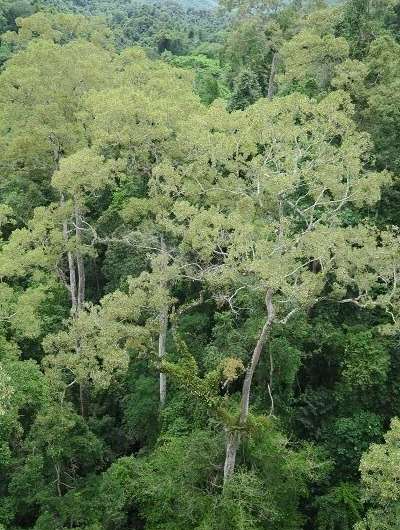Epiphytic bryophytes in Xishuangbanna tropical rainforest. Credit: Song Liang
Epiphytic communities offer an original framework to disentangle the contributions of environmental filters, biotic interactions and dispersal limitations to community structure at fine spatial scales. Bryophytes are ideal models to investigate the impact of microclimatic variation on community composition. However, no studies have examined the relationship between microclimatic variation and species composition in a spatially explicit framework for epiphytes.
In a study published in Journal of Ecology, researchers from the Xishuangbanna Tropical Botanical Garden (XTBG) of the Chinese Academy of Sciences and their collaborators attempted to determine whether variations in light, microclimatic conditions and host tree size affect the variation in species composition and phylogenetic structure of epiphytic bryophyte communities.
By then, they assessed the contribution of environmental filtering, phylogenetic constraints and competition to community assembly.
By employing a canopy crane giving access to 1.1 ha of tropical rainforest in Xishuangbanna, Yunnan, the researchers recorded hourly light and microclimatic conditions from 54 dataloggers and epiphytic bryophyte communities from 408 plots.
Rich epiphytic diversity in Xishuangbanna tropical rainforest. Credit: Song Liang
They then implemented Generalized Dissimilarity Modeling to analyze the relationship between taxonomic and phylogenetic turnover among epiphytic communities, host-tree characteristics and microclimatic variation.
The results showed that vertical variation in light, temperature and humidity conditions are the main driver of epiphytic species turnover along a tree. Epiphytic bryophyte communities were phylogenetically clustered, and the low, but significant correlation between phylogenetic turnover among communities and vertical microclimatic variation evidences fine-scale phylogenetic niche conservatism.
"We speculate that competition plays an important role in epiphytic bryophytes. However, contrary to our expectation, microclimatic variation is the main driver of community composition and phylogenetic structure, evidencing the role of phylogenetic niche conservatism in community assembly," said Song Liang of XTBG.
More information: Ting Shen et al, Microclimatic variation in tropical canopies: a glimpse into the processes of community assembly in epiphytic bryophyte communities, Journal of Ecology (2022). DOI: 10.1111/1365-2745.14011
Journal information: Journal of Ecology
Provided by Chinese Academy of Sciences

























